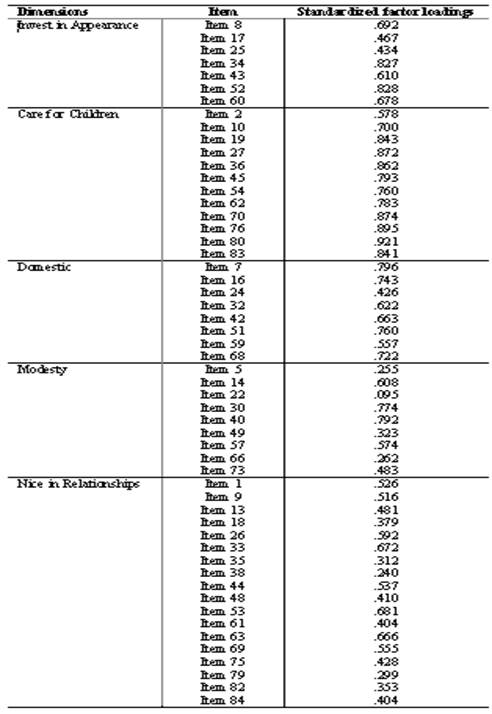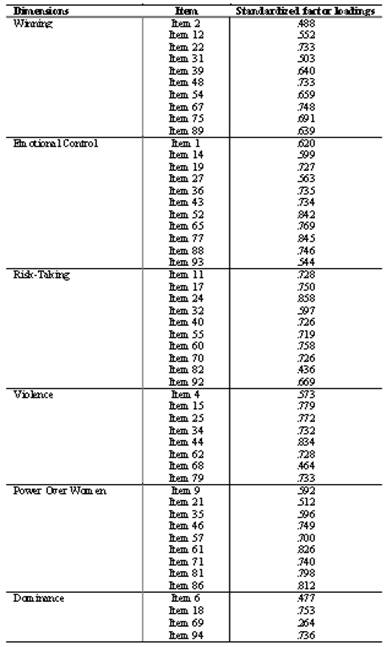Servicios Personalizados
Revista
Articulo
Links relacionados
Compartir
Ciencias Psicológicas
versión impresa ISSN 1688-4094versión On-line ISSN 1688-4221
Cienc. Psicol. vol.16 no.2 Montevideo dic. 2022 Epub 01-Dic-2022
https://doi.org/10.22235/cp.v16i2.2479
Original Articles
Conformity to Feminine and Masculine Norms Inventories: factorial structure and invariance analysis
1 Universidade Salgado de Oliveira, Brasil, juliacaciano@gmail.com
2 Universidade São Francisco, Brasil
This study aimed to evaluate the factorial structure and analyze the parameter invariance of the items of the Conformity to Feminine Norms Inventory and the Conformity to Masculine Norms Inventory in the Brazilian context. The participants were 724 female and 555 male college students. Participants answered the instruments and a sociodemographic questionnaire. Through confirmatory factor analyses, the original structures composed of first-order correlated factors were tested and partially corroborated. In addition, modifications were suggested to improve the psychometric quality of the instruments. Finally, multigroup factor analyses indicated the factorial invariance with regard to the marital status, sexual orientation, college course area and application mode. These results present initial evidence of the validity of the instruments in Brazil and support their use in future gender studies.
Keywords: femininity; female gender norms; masculinity; masculine gender norms; factorial analysis; brazilian college students
O presente estudo teve como objetivos avaliar a estrutura fatorial e analisar a invariância dos parâmetros dos itens do Inventário de Conformidade com as Normas Femininas e do Inventário de Conformidade com as Normas Masculinas no contexto brasileiro. Participaram 724 mulheres e 555 homens, estudantes universitários. Os participantes responderam aos instrumentos e a um questionário sociodemográfico. Por meio de análises fatoriais confirmatórias, as estruturas originais compostas por fatores correlacionados foram testadas e parcialmente corroboradas. Ademais, foram sugeridas modificações para melhoria da qualidade psicométrica dos instrumentos. Por fim, análises fatoriais multigrupos indicaram a invariância fatorial em relação ao estado civil, orientação sexual, área do curso de graduação e modo de aplicação. Estes resultados apresentam evidências iniciais de validade dos instrumentos no Brasil e sustentam sua utilização em estudos futuros envolvendo a temática de gênero.
Palavras-chave: feminilidade; normas de gênero feminino; masculinidade; normas de gênero masculino; análise fatorial; universitários brasileiros
El presente estudio tuvo como objetivo evaluar la estructura factorial y la invarianza factorial del Inventario de Conformidad con las Normas Femeninas y el Inventario de Conformidad con las Normas Masculinas en el contexto brasileño. Participaron 724 mujeres y 555 hombres, estudiantes universitarios. Los participantes respondieron los instrumentos y un cuestionario sociodemográfico. A través de análisis factoriales confirmatorios, las estructuras originales compuestas por factores correlacionados fueron probadas y corroboradas parcialmente. Además, se sugirieron modificaciones para mejorar la calidad psicométrica de los instrumentos. Por último, los análisis factoriales multigrupos indicaron la invarianza factorial en relación con el estado civil, la orientación sexual, zona del curso de graduación y método de aplicación. Estos resultados presentan evidencia inicial de la validez de los instrumentos en Brasil y apoyan su uso en estudios futuros que involucren el tema de género.
Palabras clave: feminidad; normas de género femeninas; masculinidad; normas de género masculinas; análisis factorial; universitarios brasileños
Cultural, educational and historical conditions (Scott, 1995) influence the understanding of gender. In the Brazilian society, through the patriarchal structure, men hold a series of social privileges, implying in the way they deal with and relate to women (Rodrigues et al., 2018). In the context of marriage, for example, even if both partners work, most of the domestic tasks, such as taking care of the house and children, tidying up, washing and ironing, are the responsibility of the woman (Jablonski, 2010).
Thus, the adaptation of psychometric instruments to evaluate the agreement with social expectations in function of gender should consider the use of different techniques to obtain validity evidence in Brazilian samples (Borsa et al., 2012). Concretely, the validity evidence based on the internal structure indicates whether the instrument items fit the construct the instrument is based on, starting from three aspects, namely dimensionality, measure invariance and reliability. Dimensionality verifies whether the interrelations between the items support the results obtained with the instrument and the inferences made. On the other hand, the invariance of the measure indicates whether the characteristics of the items are equivalent among different groups of respondents. Finally, reliability demonstrates how consistent the scores obtained are in repeated applications (Rios & Wells, 2014).
It should be noted that the invariance of the measure allows the reduction of bias, that is, a decrease in the tendency to give a single answer or a certain set of answers (American Psychological Association (APA), 2015). In addition, this technique favors justice between the different respondent subgroups, enabling proper comparison (American Educational Research Association (AERA) et al., 2014). In Brazil, however, the number of studies involving the measure invariance of psychometric instruments is still scarce (Damásio, 2013).
The Conformity to Feminine Norms Inventory (CFNI; Mahalik et al., 2005) and the Conformity to Masculine Norms Inventory (CMNI; Mahalik et al., 2003) are self-reported instruments developed to assess different attitudes, beliefs and behaviors involving the social expectations considering women and men.
For the development of the CFNI and the CMNI, an extensive review of the literature on femininity and masculinity was carried out. Then, focus groups were held to construct and refine the items. Subsequently, the instruments were applied to a sample of university students. Exploratory factor analyses presented an 84-item solution grouped into eight factors for the CFNI, and 94 items grouped into eleven factors for the CMNI (Mahalik et al., 2003; Mahalik et al., 2005).
A recent systematic review of the psychometric properties of these instruments (Silva et al., 2020) demonstrated that both contain cross-cultural adaptations in countries such as Spain (Cuellar-Flores et al., 2011; Sánchez-López et al., 2009) and Chile (Rivas-Diez et al., 2018), in addition to the existence of abbreviated forms of application in Slovakia (Lyocsa & Lyocsa, 2013), Sweden (Kling et al., 2017) and China (Rochelle & Yim, 2015). Both, in the complete and in the short versions, presented adequate psychometric indicators.
Nevertheless, few studies have looked at the factorial structure and analyzed the parameter invariance of the CFNI and CMNI items. For example, the confirmatory factor analyses of the CFNI by Parent and Moradi (2010) showed that a single factor grouped two distinct behaviors (relationship with others and seeking to maintain friendships), which made it impossible to properly measure these behaviors. In another study, the confirmatory factor analyses conducted indicated that only nine of the eleven original CMNI factors were coherent (Parent & Moradi, 2009).
As for invariance analyses, studies developed with short versions of the CMNI suggested partial metric invariance in relation to the respondent's gender and ethnicity (Hsu & Iwamoto, 2014; Parent & Smiler, 2013). In addition, the findings of the Parent and Moradi study (2011) suggested partial metric invariance between white and non-white respondents for a short version of the CFNI. Through the social context that permeates the construction of femininity and masculinity (Scott, 1995), it is justified to analyze some of the factors that influence the agreement with social expectations targeting women and men.
Based on these considerations, the aim in this study was to evaluate the factorial structure and analyze the items parameter invariance in the aforementioned instruments. As the original structures underlying the instruments were composed of correlated factors (Mahalik et al., 2003; Mahalik et al., 2005), the following hypotheses were formulated: the CFNI and the CMNI would present appropriate model adjustment indices in the studied samples (H1); positive and significant correlations would be observed between the dimensions of the instruments (H2).
Regarding the parameter invariance of the items, the study sample was subdivided in relation to marital status, sexual orientation, college course area and application mode (face-to-face or online). In the context of love relationships, empirical evidence has shown that, for men, the omission of feelings is more frequent when, for example, these relationships end, while this condition can be considered as an opportunity to engage with other people (Marcondes et al., 2006).
For sexual orientation, however, studies suggest that there is a certain social drive for affective relationships to proceed in a heterosexual way (Butler, 2003). Thus, people who experience other types of sexualities may find it more difficult to tell their families and get social support (Silva et al., 2015). Regarding professional choices, there have been multiple barriers that women face in getting access to higher education courses typified as male, such as in Exact Sciences, Engineering and Computer science (Queiroz et al., 2014).
In addition, the literature indicates the existence of correlation between instruments applied face-to-face and online (Pritchard et al., 2017), however, the verification of the item parameters in these versions makes the use of the instruments safer. In the computerized version, the absence of the applicator can cause losses, due to the variables involved in this application mode. In spite of these differences, however, it would be desirable to avoid changes in the parameters of the CFNI and CMNI items in these different groups, which would help in reducing the biases (Damásio, 2013) and would increase justice in the use of these instruments (AERA et al., 2014). Given these considerations, the following hypotheses were formulated: the parameters of the CFNI and CMNI items would be invariant in relation to marital status (H3), sexual orientation (H4), college course area (H5) and application mode (H6).
Method
Participants
The study participants were 724 women aged 17 to 62 years (M= 24.02; SD= 6.66) and 555 men aged 17 to 58 years (M= 24.11; SD= 6.54), mostly coming from four regions of the country: Paraná (26 % of women and 21.6 % of men), São Paulo (21.4 % of women and 10.8 % of men), Rio de Janeiro (17.8 % of women and 32.8 % of men) and Minas Gerais (17.4 % of women and 16.9 % of men). In general, participants were college students (75.9 % of women and 82.1 % of men), single (81.1 % of women and 83.4 % of men) and heterosexual (78.0 % of women and 84.4 % of men).
Instruments
Conformity to Feminine Norms Inventory (CFNI; Mahalik et al., 2005). The instrument contains 84 items grouped into eight female norms that deal with: Invest in Appearance, Care for Children, Domestic, Modesty, Nice in Relationships, Romantic Relationship, Sexual Fidelity, and Thinness. Answers are given on a four-point Likert-type scale, ranging from 0 (Strongly disagree) to 3 (Strongly agree). Example item from the Nice in Relationships dimension: it is important to let people know they are special. The internal consistency in the original study, assessed using Cronbach's alpha coefficient, ranged from .77 (Romantic Relationship) to .92 (Care for Children).
Conformity to Masculine Norms Inventory (CMNI; Mahalik et al., 2003). The instrument contains 94 items grouped into eleven male norms that deal with: Winning, Emotional Control, Risk-Taking, Violence, Power Over Women, Dominance, Playboy, Self-Reliance, Primacy of Work, Disdain for Homosexuals, and Pursuit of Status. The response scale is equal to that of the CFNI. Example item from the Emotional Control dimension: it is best to keep your emotions hidden. The internal consistency in the original study, assessed using Cronbach's Alpha coefficient, ranged from .72 (Pursuit of Status) to .91 (Emotional Control).
Sociodemographic information questionnaire. A questionnaire containing questions related to the following aspects was used: gender, age, marital status, sexual orientation, education, undergraduate degree and state of residence in the country.
Data collection procedures and ethical considerations
The adaptation process of the CFNI and the CMNI to the Brazilian population followed the guidelines of the professional regulator (CFP, 2018). For the idiomatic adaptation, back-translation was used (Muñiz et al., 2013), a procedure often employed for this purpose. Initially, an independent translator translated the items from English to Portuguese. Then, another independent translator back-translated the items translated into Portuguese into English. Finally, the authors performed a semantic analysis of the translated items, comparing them with the original version.
The research was submitted to the Research Ethics Committee of the authors' institution and approved under CAAE No 71481417.8.0000. Data collection was performed in the face-to-face and online versions. In the face-to-face version, the protocols were completed in group in the classroom. In the online version, a form was created in Google Docs and invitations were sent by email or social networks. In both versions, it took an average 20 minutes to apply the instrument. The participants were informed about the ethical aspects of the research and expressed their agreement by signing the free and informed consent form (ICF).
Data analysis
To verify the factorial structure of the instruments, confirmatory factor analyses were conducted with maximum likelihood estimation in Mplus, version 7.11. The following indices of fit to the model were analyzed: Chi-square (χ², the lower the value, the better the fitness to the data), Root Mean Square Error of Approximation (RMSEA, should be below 0.06) with 90 % confidence interval, Comparative Fit Index (CFI, values above 0.90 are considered acceptable) and Tucker-Lewis Index (TLI, values above 0.90 are considered acceptable).
To evaluate the parameter invariance of the items in relation to marital status, sexual orientation, college course area and application mode, multigroup factor analyses were conducted (Damasio, 2013). For the CFNI, however, comparing how the instrument was applied was not possible because the number of participants in each of the subgroups (face-to-face and online) was unbalanced.
In this analysis, three levels of invariance of the measure were verified: configural invariance, which admits the equivalence as to the number of factors and the corresponding items; metric invariance, which admits the previous equivalence and the equality in the factor loadings; and scalar invariance, which admits the two previous equivalence modalities, as well as the equality of the intercepts (Kline, 2011; Rios & Wells, 2014). According to existing recommendations in the literature, the measure invariance is supported by a change of 0.01 at most in the RMSEA and CFI indices (Cheung & Rensvold, 2002).
Results
In the analysis of the factorial structure of the instruments, the correlated factor models for the CFNI and the CMNI were tested. The results showed that the CMNI did not obtain adequate model fit indices (χ2 (gl) = 8535.007 (4222); CFI = 0.85; TLI = 0.84; RMSEA = 0.04; CI = 0.03. 0.04). On the other hand, the CFNI obtained slightly adequate adjustment indices (χ2 (gl) = 8941.966 (3374); CFI = 0.91; TLI = 0.90; RMSEA = 0.04; CI = 0.04. 0.04), so that hypothesis 1 was partially supported.
Tables 1 1a and 2 2a show the standardized factor loadings of the instrument items. It can be noted that most of the items obtained a standardized loading above 0.50, except for 19 items from the CFNI and 8 items from the CMNI. These items may impact the accuracy of the dimensions of psychometric instruments (Hair et al., 2016), so that it was decided to discard the model. In the case of the CMNI, after discarding the model, one dimension related to the search for dominance maintained only with two items, being therefore discarded from the model.
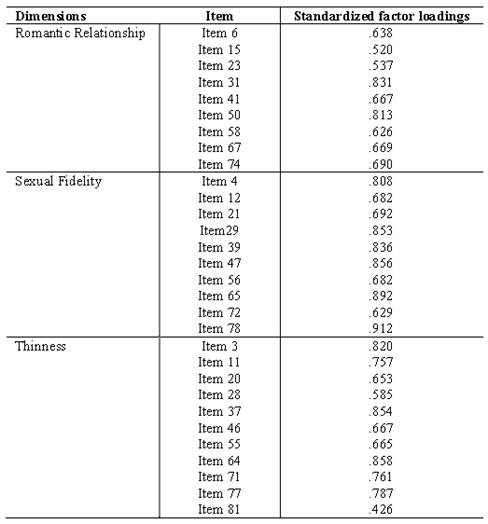
Note: All values were significant for p < .01; the numbering of the items corresponds to that found in the original version of the instrument.
Due to the results obtained, a short version of the instruments was suggested. Thus, the final Brazilian version of the CFNI was composed of 65 items, distributed in eight dimensions. In turn, the final Brazilian version of the CMNI was composed of 86 items, distributed in ten dimensions. Subsequent analyses were performed according to these models.
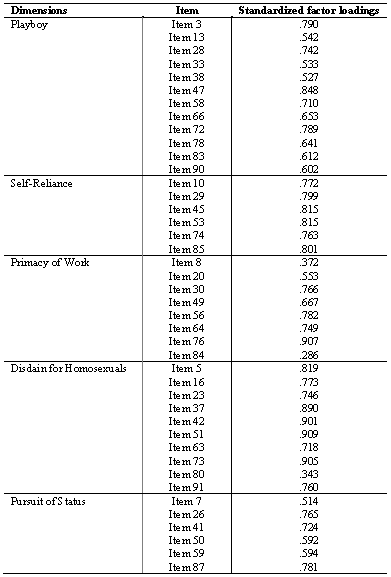
Note: All values were significant for p < .01; the numbering of the items corresponds to that found in the original version of the instrument; the Dominance dimension was removed from the Brazilian model.
The internal consistency ratios were calculated using the average variance extracted (AVE). Coefficients for this indicator should be .50 or higher (Fornell & Larcker, 1981). In the CFNI, the following AVE coefficients were obtained: .52 (Invest in Appearance), .66 (Care for Children), .48 (Domestic), .47 (Modesty), .35 (Nice in Relationships), .44 (Romantic Relationship), .61 (Sexual Fidelity) and .54 (Thinness). In the CMNI, the following coefficients were obtained: .43 (Winning), .49 (Emotional Control), .52 (Risk-Taking), .54 (Violence), .49 (Power Over Women), .44 (Playboy), .62 (Self-Reliance), .54 (Primacy of Work), .66 (Disdain for Homosexuals) and .44 (Pursuit of Status).
As expected by hypothesis 2, the instrument dimensions were mutually correlated. Positive and significant correlations were identified between the dimensions of the CFNI (Table 3), for example, the following correlations stand out: Care for Children and Nice in Relationships (r= .35, p< .01), and Romantic Relationship and Sexual Fidelity (r= .47, p< .01).
Table 3: Correlations between the dimensions of the Conformity to Feminine Norms Inventory

Note: * = p < 0.01. 1 = Invest in Appearance; 2 = Care for Children; 3 = Domestic; 4 = Modesty; 5 = Nice in Relationships; 6 = Romantic Relationship; 7 = Sexual Fidelity; 8 = Thinness.
In the case of the CMNI, positive and significant correlations were also identified between the instrument dimensions. The Winning dimension showed weak to moderate correlations with Risk-Taking (r= .31, p< .01), Disdain for Homosexuals (r= .34, p< .01), Power over Women (r= .35, p< .01), Primacy of Work (r= .44, p< .01) and Pursuit of Status (r= .57, p< .01). The Emotional Control dimension showed moderate correlation with the Self-Reliance dimension (r= .41, p< .01).
In addition, about the CMNI, the Violence dimension showed weak correlations with Risk-Taking (r= .30, p< .01), Disdain for Homosexuals (r= .30, p< .01) and Power over Women (r= .37, p< .01). Finally, the dimensions Power over Women and Disdain for Homosexuals showed moderate mutual correlation (r= .54, p< .01). These results are displayed in Table 4.
Table 4: Correlations between the dimensions of the Conformity to Masculine Norms Inventory
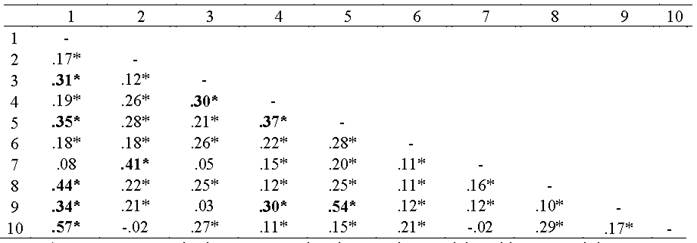
Note: * = p < .01. 1 = Winning; 2 = Emotional Control; 3 = Risk-Taking; 4 = Violence; 5 = Power Over Women; 6 = Playboy; 7 = Self-Reliance; 8 = Primacy of Work; 9 = Disdain for Homosexuals; 10 = Pursuit of Status.
Regarding the analysis of the items' parameter invariance, we started with the baseline model, contemplating only the factors and the corresponding items (configural invariance). The fitness indicators were compared to those without any constraint. The multigroup factor analyses supported the configuration invariance of the CFNI (Table 5) and CMNI (Table 6) for all variables analyzed.
Table 5: Multi-group confirmatory factor analysis to the Conformity to Feminine Norms Inventory
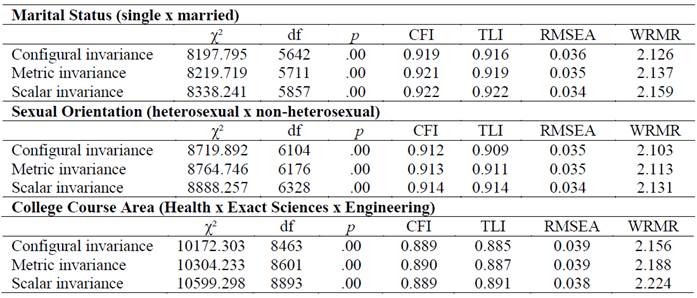
Note: df = degrees of freedom; CFI = Comparative Fit Index; TLI = Tucker-Lewis Index; RMSEA = Root Mean Square Error of Approximation; WRMR = Weighted Root Mean Square Residual. n single = 587; n married = 126; n heterosexual = 538; n non-heterosexual = 152; n Health = 175; n Exact Sciences = 121; n Engineering = 101.
In a second phase, the factor loadings of the items were constrained (metric invariance) and the indicators suggested that the CFNI and CMNI remained invariant for all variables analyzed. Finally, in addition to the assumptions established in the configural and metric invariances, the intercepts were also considered as equivalent (scalar invariance). In this last phase, the indicators suggested that the CFNI and the CMNI were also invariant for all the variables analyzed. These results showed that, for the correlated factor model, the item parameters are invariant between the different groups analyzed, supporting hypotheses 3, 4, 5 and 6.
Table 6: Multi-group confirmatory factor analysis to the Conformity to Masculine Norms Inventory
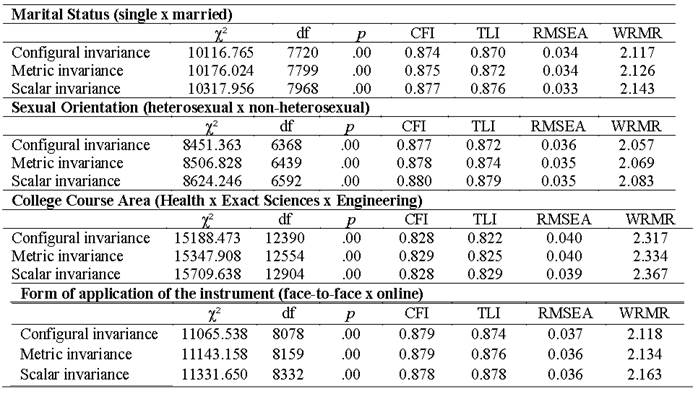
Note: df = degrees of freedom; CFI = Comparative Fit Index; TLI = Tucker-Lewis Index; RMSEA = Root Mean Square Error of Approximation; WRMR = Weighted Root Mean Square Residual. n single = 462; n married = 79; n heterosexual = 432; n non-heterosexual = 80; n Health = 148; n Exact Sciences = 135; n Engineering = 140; n face-to-face = 399; n online = 155.
Discussion
This study aimed to evaluate the factorial structure of the Conformity to Feminine Norms Inventory and the Conformity to Masculine Norms Inventory. In addition, the study sought to analyze the parameter invariance of the instrument items in relation to marital status, sexual orientation, college course area and application mode.
The data observed in the confirmatory factor analyses indicated that the original structure of the CMNI did not reach the recommended cut-off points. Thus, hypothesis 1 was partially corroborated. Although this result is inconsistent with the study by Mahalik et al. (2003), it is feasible that it occurred because of existing cultural differences between the two countries.
In addition, weak factor loadings were identified in some items, so that they were discarded. Hence, the final versions of the CFNI and the CMNI were composed of 65 and 86 items, respectively. It should be noted that the Dominance dimension, discarded from the Brazilian model, also presented inadequate coefficients in previous studies (Cuéllar-Flores et al., 2011; Parent & Moradi, 2009). Despite these results, this study adds validity evidence on the instruments' internal structure.
Regarding internal consistency indicators, the dimensions good relationships and romantic relationships of the CFNI obtained values far below the existing recommendations. Two other dimensions (Domestic and Modesty) obtained marginally lower values than the cutoff points (.48 and .47, respectively). In the CMNI, the dimensions Winning, Playboy and Pursuit of Status obtained lower AVE coefficients than the existing recommendations. Additionally, two other dimensions (Emotional Control and Power over Women) obtained marginally lower values (.49). The low internal consistency found in these dimensions entails some inaccuracy in the measure under assessment (Valentini & Damásio, 2016). This result can be explained by the lack of accuracy of some items when translated into Portuguese, as well as by the combination of items that belong to different dimensions (Maroco & Garcia-Marques, 2006). Therefore, it is suggested that further studies be carried out to review the factorial structure of the instruments.
In addition, positive and significant correlations were identified between several dimensions of the instruments, supporting hypothesis 2. The observed correlations between Romantic Relationship and Sexual Fidelity dimensions (r = .47, p < .01) of the CFNI demonstrated that, for the participants, the involvement in romantic relationship is intertwined with sexual fidelity. Also, because of the correlation observed between the dimensions Winning and Pursuit of Status in the CMNI (r= .57, p< .01), it is relevant that future studies verify whether these dimensions actually constitute two independent constructs.
Concerning the parameter invariance of the instrument items, the results supported hypotheses 3, 4, 5 and 6. The scores obtained through the instruments are invariant for single and married participants, heterosexuals and non-heterosexuals, enrolled in courses in the areas of Health, Exact Sciences or Engineering, whether they answered the pencil and paper version or the online version of the instruments. Thus, the instruments can be used in comparative studies with these variables, ruling out the possibility that possible differences in group means originate in biases caused by the measure. The invariance of the CFNI in terms of the application mode could not be analyzed though, due to the lack of balance in the number of cases in each subgroup (n face-to-face = 598; n online = 126).
Despite the validity evidence based on the internal structure found, the limitations of the study should be reported. The first is the fact that the participants' level of social desirability was not evaluated. Thus, the participants may have answered some items through their personal judgment of what would be socially appropriate. Another limitation is the sample composed predominantly of white, heterosexual and single college students. It should be noted that this type of sample was used to maintain similarity with the category studied in the original version of the instruments. The results obtained here should not be generalized to individuals with other characteristics though.
As for the future research agenda, studies involving Brazilian workers are suggested, because these public experiences different factors in the gender and work dyad. One example are beliefs involving the existence of professions more suitable for women and for men, which can influence professional choice. Measuring the agreement with social expectations targeting their gender and other variables (such as self-efficacy, work-family conflict, criteria for professional choices and attitudes towards leadership positions) could contribute to the deepening of the construct's nomological network.
Finally, it should be noted that the instruments do not seek to identify the respondents' levels of femininity or masculinity, but rather their attitudes, beliefs and behaviors associated with the gender norms evaluated. Although the participants presented different characteristics, the instruments remained invariant for the subgroups verified, ensuring their use to evaluate the agreement with social gender norms in Brazilian participants (AERA et al., 2014; Damasio, 2013). The instruments can be of help in interventions to assess compliance with social expectations targeting women and men, constituting a tool for use in both clinical and organizational contexts.
REFERENCES
American Educational Research Association (AERA), American Psychological Association (APA), & National Council on Measurement in Education (NCME). (2014). Standards for Educational and Psychological Testing. American Educational Research Association. [ Links ]
American Psychological Association (APA). (2015). APA Dictionary of Psychology (2a ed.). American Psychological Association. [ Links ]
Borsa, J. C., Damásio, B. F., & Bandeira, D. R. (2012). Adaptação e validação de instrumentos psicológicos entre culturas: Algumas considerações. Paidéia, 22(53), 423-432. https://doi:10.1590/S0103-863X20120003000144 [ Links ]
Butler, J. (2003). Problemas de gênero: Feminismo e subversão da identidade. Civilização Brasileira. [ Links ]
Cheung, G. W. & Rensvold, R. B. (2002). Evaluating goodness-of-fit indexes for testing measurement invariance. Structural Equation Modeling, 9(2), 233-255. https://doi:10.1207/S15328007SEM0902_55 [ Links ]
Conselho Federal de Psicologia (CFP). (2018). Resolução CFP n.° 09, de 25 de abril de 2018. https://satepsi.cfp.org.br/docs/ResolucaoCFP009-18.pdf [ Links ]
Cuéllar-Flores, I., Sánchez-López, M. D. P., & Dresch, V. (2011). El inventario de conformidad con las normas de género masculinas (CMNI) en la población española. Anales de Psicologia, 27(1), 170-178. [ Links ]
Damásio, B. F. (2013). Contribuições da análise fatorial confirmatória multigrupo (AFCMG) na avaliação de invariância de instrumentos psicométricos. Psico-USF, 18(2), 211-220. https://doi:10.1590/S1413-82712013000200005 [ Links ]
Fornell, C. & Larcker, D. F. (1981). Evaluating structural equations models with unobservable variables and measurement error. Journal of Marketing, 18(1), 39-50. https://doi:10.2307/3151312 [ Links ]
Hair, J. F., Hult, G. T. M., Ringle, C. M., & Sarstedt, M. A. (2016). Primer on partial least squares structural equation modeling (PLS-Sem). Sage. [ Links ]
Hsu, K. & Iwamoto, D. K. (2014). Testing for measurement invariance in the conformity to masculine norms-46 across white and asian american college men: Development and validity of the CMNI-29. Psychology of Men and Masculinity, 15(4), 397-406. https://doi:10.1037/a0034548 [ Links ]
Jablonski, B. (2010). A divisão de tarefas domésticas entre homens e mulheres no cotidiano do casamento. Psicologia: Ciência e Profissão, 30(2), 262-275. https://doi:10.1590/S1414-98932010000200004 [ Links ]
Kline, R. B. (2011). Principles and practice of structural equation modeling (3a ed.). The Guilford Press. [ Links ]
Kling, J., Holmqvist Gattario, K., & Frisén, A. (2017). Swedish women’s perceptions of and conformity to feminine norms. Scandinavian Journal of Psychology, 58(3), 238-248. https://doi.org/10.1111/sjop.12361 [ Links ]
Lyócsa, I. & Lyócsa, S. (2013). Confirmatory factor analysis of the abbreviated Conformity to Feminine Norms Inventory. Social Work Research, 37(4), 414-422. https://doi:10.1093/swr/svt034 [ Links ]
Mahalik, J. R., Locke, B. D., Ludlow, L. H., Diemer, M. A., Gottfried, M., Scott, R. P. J., & Freitas, G. (2003). Development of the Conformity to Masculine Norms Inventory. Psychology of Men & Masculinity, 4(1), 3-25. https://doi:10.1037/1524-9220.4.1.3 [ Links ]
Mahalik, J. R., Morray, E. B., Coonerty-Femiano, A., Ludlow, L. H., Slattery, S. M., & Smiler, A. P. (2005). Development of the Conformity to Feminine Norms Inventory. Sex Roles, 52(7-8), 417-435. https://doi:10.1007/s11199-005-3709-7 [ Links ]
Marcondes, M. V., Trierweiler, M., & Cruz, R. M. (2006). Sentimentos predominantes após o término de um relacionamento amoroso. Psicologia: Ciência e Profissão , 26(1), 94-105. https://doi:10.1590/S1414-98932006000100009 [ Links ]
Maroco, J. & Garcia-Marques, T. (2006). Qual a fiabilidade do alfa de Cronbach? Questões antigas e soluções modernas? Laboratorio de Psicologia, 4(1), 65-90. https://doi:10.14417/lp.763 [ Links ]
Muñiz, J., Elosua, P., & Hambleton, R. K. (1996). Directrices para la traducción y adaptación de los tests: Segunda edición. Psicothema, 25(2), 151-157. https://doi.org/10.7334/psicothema2013.24 [ Links ]
Parent, M. C. & Moradi, B. (2009). Confirmatory factor analysis of the Conformity to Masculine Norms Inventory and development of the Conformity to Masculine Norms Inventory-46. Psychology of Men & Masculinity , 10(3), 175-189. https://doi:10.1037/a0015481 [ Links ]
Parent, M. C. & Moradi, B. (2010). Confirmatory factor analysis of the Conformity to Feminine Norms Inventory and development of an abbreviated version: the CFNI-45. Psychology of Women Quarterly, 34, 97-109. https://doi:10.1037/a0015481 [ Links ]
Parent, M. C. & Moradi, B. (2011). An abbreviated tool for assessing feminine norm conformity: Psychometric properties of the Conformity to Feminine Norms Inventory-45. Psychological Assessment, 23(4), 958-969. https://doi:10.1037/a0024082 [ Links ]
Parent, M. C. & Smiler, A. P. (2013). Metric invariance of the Conformity to Masculine Norms Inventory-46 among women and men. Psychology of Men & Masculinity , 14(3), 324-328. https://doi:10.1037/a0027642 [ Links ]
Pritchard, A. E., Stephan, C. M., Zabel, T. A., & Jacobson, L. A. (2017). Is this the wave of the future? Examining the psychometric properties of child behavior ratings administered online. Computers in Human Behavior, 70(4), 518-522. https://doi:10.1016/j.chb.2017.01.030 [ Links ]
Queiroz, C. T. A. P., Carvalho, M. E. P., & Moreira, J. A. (2014). Gênero e inclusão de jovens mulheres nas ciências exatas, nas engenharias e na computação. Anais do 18° REDOR. Universidade Federal Rural de Pernambuco. https://www.ufpb.br/evento/index.php/18redor/18redor/paper/viewFile/2076/855 [ Links ]
Rios, J. & Wells, C. (2014). Validity evidence based on internal structure. Psicothema , 26(1), 108-116. https://doi:10.7334/psicothema2013.260 [ Links ]
Rivas-Diez, R., Brabete, A. C., & Sánchez-López, M. D. P. (2018). Evaluación de la variable género: CFNI en mujeres chilenas. Revista Iberoamericana de Diagnóstico y Evaluación, 48(3), 117-125. https://doi:10.21865/RIDEP48.3.10 [ Links ]
Rochelle, T. L. & Yim, K. H. (2015). Assessing the factor structure of the chinese Conformity to Masculine Norms Inventory. The Journal of Psychology, 149(1), 29-41. https://doi:10.1080/00223980.2013.837023 [ Links ]
Rodrigues, A. O., Reis, B. R. N., & Quadrado, J. C. (2018). A influência da sociedade patriarcal na identidade feminina. Anais do 10° Salão Internacional de Ensino Pesquisa e Extensão (SIEPE). Universidade Federal do Pampa. https://200.132.146.161/index.php/siepe/article/view/40244 [ Links ]
Sánchez-López, M. D. P., Cuéllar-Flores, I., Dresch, V., & Aparicio-García, M. E. (2009). Conformity to feminine gender norms in the spanish population. Social Behavior and Personality, 37(9), 1171-1186. https://doi:10.2224/sbp.2009.37.9.1171 [ Links ]
Scott, J. (1995). Gênero: Uma categoria útil de análise histórica. Educação & Realidade, 20(2), 71-99. [ Links ]
Silva, J. C., Valentini, F., & Freitas, C. P. P. (2020). Gender conformity norms: A systematic review of validity evidence. Revista Psicología para America Latina, 34. [ Links ]
Silva, M. M. L., Frutuozo, J. F. F., Feijó, M. R., Valerio, N. I., & Chaves, U. H. (2015). Família e orientação sexual: Dificuldades na aceitação da homossexualidade masculina. Temas em Psicologia, 23(3), 677-692. https://doi:10.9788/TP2015.3-12 [ Links ]
Valentini, F. & Damásio, B. F. (2016). Variância média extraída e confiabilidade composta: Indicadores de precisão. Psicologia: Teoria e Pesquisa, 32(2), 1-7. https://doi:10.1590/0102-3772e322225 [ Links ]
How to cite: Silva, J. C. & Valentini, F. (2022). Conformity to Feminine and Masculine Norms Inventories: factorial structure and invariance analysis. Ciencias Psicológicas, 16(2), e-2479. https://doi.org/10.22235/cp.v16i2.2479
Authors’ participation: a) Conception and design of the work; b) Data acquisition; c) Analysis and interpretation of data; d) Writing of the manuscript; e) Critical review of the manuscript. J. C. S. has contributed in a, b, c, d; F. V. in a, c, e.
Received: February 27, 2021; Accepted: May 31, 2022











 texto en
texto en 


